 W
WAll Saints Church in Palmerston North, New Zealand, is an Anglican heritage-registered church designed by eminent architect Frederick de Jersey Clere. The church has been closed since 2013 over concerns about earthquake resistance but there are plans to strengthen the structure.
 W
WThe Auckland Ferry Terminal, sometimes called the Downtown Ferry Terminal or simply Ferry Building, is the hub of the Auckland ferry network that connects Auckland City with suburbs in North Shore, west Auckland, and south Auckland, and islands in the Waitematā Harbour and Hauraki Gulf. The ferry terminal is in the Auckland CBD on the Auckland waterfront. It is at the north end of Queen Street, opposite the Britomart Transport Centre, which is the hub for local buses and trains.
 W
WAuckland Town Hall is a Edwardian building on Queen Street in the Auckland CBD, New Zealand, known both for its original and ongoing use for administrative functions, as well as its famed Great Hall and separate Concert Chamber. Auckland Town Hall and its surrounding context is highly protected as a 'Category A' heritage site in the Auckland District Plan.
 W
WThe Bank of New Zealand Te Aro branch building is an historic building on the corner of Manners and Cuba Street, Wellington, New Zealand.
 W
WBaradene College of the Sacred Heart is a Catholic high school for girls aged from 11 to 18 located in Remuera, Auckland, New Zealand. It is based on the philosophy of Madeleine Sophie Barat, who founded the Society of the Sacred Heart.
 W
WCape Brett Lighthouse is a lighthouse at Cape Brett in the Northland Region of the North Island of New Zealand. The site was surveyed and chosen in 1908 by Captain John Bollons of NZGSS Hinemoa.
 W
WCastle Point Lighthouse, located near the village of Castlepoint in the Wellington Region of the North Island of New Zealand, is the North Island's tallest lighthouse standing 52 metres above sea level and is one of only two left in New Zealand with a rotating beam. It is owned and operated by Maritime New Zealand.
 W
WThe Colonial Ammunition Company (CAC) was an ammunition manufacturer in Auckland, New Zealand. Its predecessor, Whitney & Sons, was established by Major John Whitney with government encouragement in 1885 during the Russian Scare. Whitney later recruited investors to expand his factory in 1888. The other shareholders were Messrs Greenwood and Batley, of Leeds ; T. Hall, Esq., of Mount Morgan; J. D' Arcey, Esq.; Captain de Lusada, R.N.; J. Clarke, Esq.; and T.Y. Cartwright of Notts. They formed the Colonial Ammunition Company, the first ordnance manufacturer in Australasia.
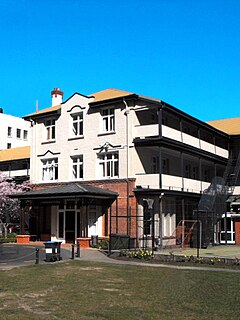 W
WCumberland College is a residential college in Dunedin, New Zealand for the University of Otago. Cumberland College was established as a hall of residence in 1989. It is located in the former Dunedin Hospital Nurses' Home, built in 1916, across the road from Dunedin Hospital and the Queen Mary Maternity Hospital. Cumberland College is linked by tunnels to both Dunedin Hospital and Hayward College. Over 7000 students have spent time living in Cumberland College since its establishment.
 W
WEdith Cavell Bridge is a bridge over the Shotover River in the Otago region in the South Island of New Zealand that stands at 47.8 metres (157 ft) tall. It is registered by Heritage New Zealand as a Category I heritage structure.
 W
WElliott House is a historic building in Wellington, New Zealand.
 W
WThe former Government Buildings in Hokitika, also known as Seddon House, are on the West Coast of the South Island of New Zealand. The building is classified as a "Category I" historic place by Heritage New Zealand Pouhere Taonga, previously known as the New Zealand Historic Places Trust.
 W
WGovernment House, Wellington, is the principal residence of the Governor-General of New Zealand, the representative of the New Zealand head of state, Queen Elizabeth II. Dame Patsy Reddy, who has been Governor-General since September 2016, currently resides there with her spouse. The present building, the third Government House in Wellington, was completed in 1910. It is located in the Newtown suburb of the city.
 W
WGrafton Bridge is a road bridge spanning Grafton Gully in Auckland, New Zealand. Built of reinforced concrete in 1910, it connects the Auckland CBD and Karangahape Road with Grafton. It spans about 97.6 metres (320 feet), rises 25.6 metres (84 feet) above the abutments to a height of around 43 metres (142 feet) over the gully. When the bridge was constructed, it contained the largest reinforced concrete arch in the world.
 W
WThe Hanover Street Baptist Church was the first Baptist church in Dunedin, New Zealand.
 W
WHorahora Power Station was an early hydroelectric power station on the Waikato River in New Zealand. It was the country’s first large-scale power station, completed in 1913. Initially built to service a gold mine, the power station was expanded to supply a significant part of the North Island. The power station remained in use until was submerged by Lake Karapiro, which was formed to supply the larger Karapiro Power Station.
 W
WKnox College is a selective residential college, established by the Presbyterian Church of Aotearoa New Zealand and affiliated with University of Otago in Dunedin, New Zealand. The college is set in a 4.57 hectares landscaped site in Opoho on the opposite side of the Dunedin Botanic Gardens from the University. It is named after John Knox, a sixteenth century leader of the Scottish Reformation, whose efforts in establishing a universal system of free education comprising both academic learning and character formation had a profound influence, not just in Scotland, but internationally, as subsequent generations of Scottish settlers, products of the Scottish Enlightenment, emigrated to far-flung corners of the globe, including New Zealand, taking with them a deep-seated belief in the benefits of applied knowledge and a broad and liberal education. Those strong Scottish Presbyterian foundations are something that Knox College has in common with the University to which it is affiliated. They are depicted on the college's Coat of Arms in the form of a blue St Andrew's Cross. Superimposed on the St Andrew's Cross is the image of a white dove in flight, carrying an olive branch in its mouth, a symbolic depiction of the flood myth in Genesis 8, wherein the olive-branch-bearing dove is a symbol of life and peace. The college motto, Gratia et Veritas (Latin), or Grace and Truth (English), comes from the Prologue to the Gospel according to Saint John
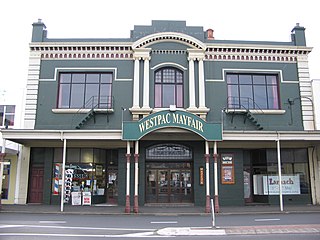 W
WThe Mayfair Theatre, Dunedin, New Zealand, was opened on 8 December 1914 as the "King Edward Picture Theatre". It is owned by the Mayfair Theatre Charitable Trust and serves as a 400-seat venue for live performances for a number of local community groups and as the Dunedin venue for some touring agencies.
 W
WThe Mercury Theatre is a theatre in Auckland, New Zealand, located on Mercury Lane, off Karangahape Road. It was built in 1910 by the architect Edward Bartley and is the oldest surviving theatre in Auckland. Built in the English Edwardian Baroque architecture style, it was initially known as the Kings Theatre. On being converted into a cinema in 1926, a new entrance was built on Karangahape Road – this is now the Norman Ng Building. The building is a Grade II Listed monument.
 W
WMount Eden Prisons consists of two separate facilities in the Auckland, New Zealand suburb of Mount Eden — the Mount Eden Prison and the Mount Eden Corrections Facility.
 W
WThe Music Centre of Christchurch was a facility for music organisations in the central city of Christchurch, New Zealand. It was established in 1994 and provides office, rehearsal, tuition and performance space for a wide range of music groups. The centre is adjacent to the Cathedral of the Blessed Sacrament and now consists of a group of four heritage buildings formerly the convent of the Sisters of Our Lady of the Missions and Sacred Heart College, a Catholic secondary school for girls founded in 1881 which was amalgamated with Xavier College, a neighbouring Catholic boys' school to form Catholic Cathedral College in 1987.
 W
WThe former Government Building is a heritage building in Christchurch, New Zealand. It was designed by Joseph Maddison in 1909. It is a Category I heritage building listed with Heritage New Zealand.
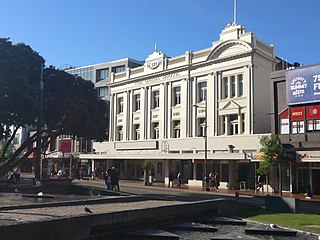 W
WThe Opera House is a proscenium theatre in Wellington, New Zealand, located on Manners Street opposite Te Aro Park.
 W
WOtago Girls' High School (OGHS) is a secondary school in Dunedin, Otago, New Zealand. It was opened 6 February 1871, after a long campaign by Learmonth Whyte Dalrymple. It is reputedly the oldest girls state-run secondary school in the Southern Hemisphere and the sixth oldest of its type in the world.
 W
WPukeora Sanatorium or Pukeora Tuberculosis Sanatorium was a tuberculosis (TB) hospital in the Hawke's Bay, New Zealand.
 W
WThe Registry Building belongs to the Christchurch Arts Centre in the Christchurch Central City of Christchurch, New Zealand. It is covered by a Category I registration by Heritage New Zealand that is separate to the Category I registration that covers the buildings in the western part of the block, and the Category II registration that applies to the former Student Union building. Designed by Collins and Harman, the Registry Building was constructed in 1916 and an extension was added ten years later. After the 2011 Christchurch earthquake, 22 of the historic buildings were red stickered. The Registry Building was the first one to be restored, and it reopened in July 2013.
 W
WRemuera Library is a local branch of Auckland Libraries, serving the suburb of Remuera. It is housed in a historic building, which is considered to be a landmark in the area.
 W
WThe Rose Historic Chapel, formerly known as the St Mary's Convent Chapel, is a heritage-listed stone church building located in Colombo Street in Christchurch, New Zealand. It is registered as a "Historic Place – Category II " by the New Zealand Historic Places Trust. The building was designed in the Gothic Revival style and erected in 1910.
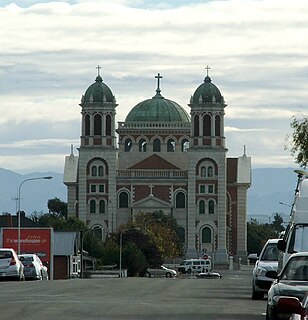 W
WThe Sacred Heart Basilica or Timaru Basilica, as it is popularly known because of its style of architecture, is a Catholic church in Timaru, New Zealand. It was designed by the prominent New Zealand architect, Francis Petre and is one of his most celebrated works. Its great size and beauty make it one of the most important historic buildings of Timaru and of the South Canterbury region. The Basilica's twin towers and copper cupola are highly visible features of the Timaru skyline, especially from the south. The Basilica is also one of the "most noteworthy examples of ecclesiastical architecture" in New Zealand with elements of "Roman and Byzantine architecture with touches of Art Nouveau decoration." It is a registered historic place, category 1.
 W
WSt. Bede's College is a state integrated Roman Catholic day and boarding school in Christchurch, New Zealand, for boys aged 12 to 18. St. Bede's is the oldest Roman Catholic Boys' College in New Zealand's South Island. It is also the only Catholic day and boarding college for boys in New Zealand's South Island. Students at St Bede's are colloquially known as Bedeans. St Bede's College was founded in 1911 by the Marists, a religious congregation founded in Lyon, France in 1816.
 W
WThe St. James Theatre is a stage theatre located in the heart of New Zealand's capital city, Wellington. The present theatre was designed in 1912 by New Zealand theatre designer Henry Eli White. The theatre currently faces on to Courtenay Place, the main street of Wellington's entertainment district, opposite the Reading Cinema complex. The building is number 83.
 W
WSaint Margaret's College, Otago is a residential college affiliated to the University of Otago in Dunedin, New Zealand. The current Master is Dr. Charles Tustin and the Dean of Students is George Connolly. The previous Master, Dr Peter Norris, retired in November 2016 after 28 years of service to the College.
 W
WSt. Mary's Basilica is a Catholic Church in Invercargill, New Zealand. It was designed by the celebrated New Zealand architect, Francis Petre and was opened in 1905. The Basilica, named such because of its style of architecture, is located near St Josephs School, the Otepuni Gardens and Te Tomairangi Marae. The building is listed as a Category I Historic Place.
 W
WSt Mary's Catholic Church in Hokitika, New Zealand, is a Roman Catholic church. It is a landmark on the country's West Coast.
 W
WSt Michael's is a co-educational Anglican private primary and intermediate day school situated in the city centre of Christchurch, New Zealand. The school provides an education for year zero to year eight. It is associated with the Church of St Michael and All Angels.
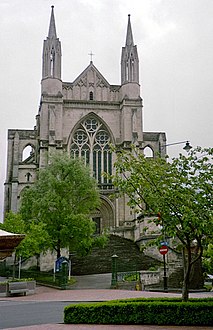 W
WSt Paul's Cathedral is the mother church of the Anglican Diocese of Dunedin in New Zealand and the seat of the Bishop of Dunedin.
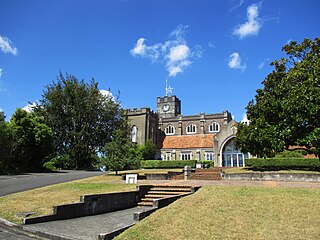 W
WSt Peter's Cathedral is the Anglican cathedral in Hamilton, located in the Waikato region of the North Island of New Zealand. It is located on a small hill, known as Cathedral Hill, in the southern central part of the city off Victoria Street.
 W
WThe Sarjeant Gallery Te Whare o Rehua Whanganui at Pukenamu, Queen's Park Whanganui is currently closed for redevelopment. The temporary premises at Sarjeant on the Quay, 38 Taupo Quay currently house the Sarjeant Collection, and all exhibitions and events. The Sarjeant Gallery is a regional art museum with a collection of international and New Zealand art.
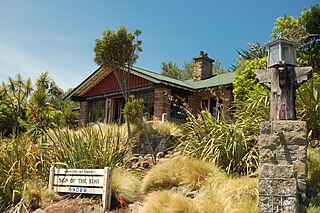 W
WThe Sign of the Kiwi, originally called Toll House, is a small café and shop at Dyers Pass on the road between Christchurch and Governors Bay. It was built in 1916–17 by Harry Ell as a staging post and opened as a tearoom and rest house. It has a Category I heritage classification by Heritage New Zealand and is a popular destination for tourists and locals alike. The building was closed some time after the 22 February 2011 Christchurch earthquake and it was not until 23 January 2017, six years later, that it opened again. Although located within the burned area, the building was not damaged by the 2017 Port Hills fires a month later.
 W
WThe Tepid Baths is a public indoor pool complex in Auckland, New Zealand. The baths opened in 1914 on a site that had previously been occupied by a small drydock and were very well-received by the public, with the new baths attracting 30,000 visitors in the first two months after opening. In 2010 the baths closed for a major refurbishment, re-opening in mid-2012 after a two year re-build.
 W
WVictoria Bridge is a steel arch bridge in Hamilton, New Zealand. The bridge has a Category I heritage protection.
 W
WVictoria Park Market is a cluster of galleries, workshops, studios, offices, eateries and retail stores as well as a gym and Pilates Studio in Auckland, New Zealand. The precinct is housed in a former waste depot and incinerator complex. It is located in Freemans Bay and its name derives from the adjacent Victoria Park which was created in 1905 and named after the late Queen who had died four years earlier.
 W
WWaitākere Reservoir is a reservoir on the Waitakere River in the Waitākere Ranges, west of Auckland in New Zealand. Waitākere Dam was completed in 1910 and is a concrete gravity dam with a slight curvature.. It has a lake area of 25.1 hectares and a capacity of 1.76 million cubic metres.
 W
WThe William Booth Memorial Training College is a building on Aro Street, in Aro Valley, Wellington, New Zealand, which currently houses the School of Practical Philosophy. It was completed in 1913, and named after one of the founders of the Salvation Army, William Booth.